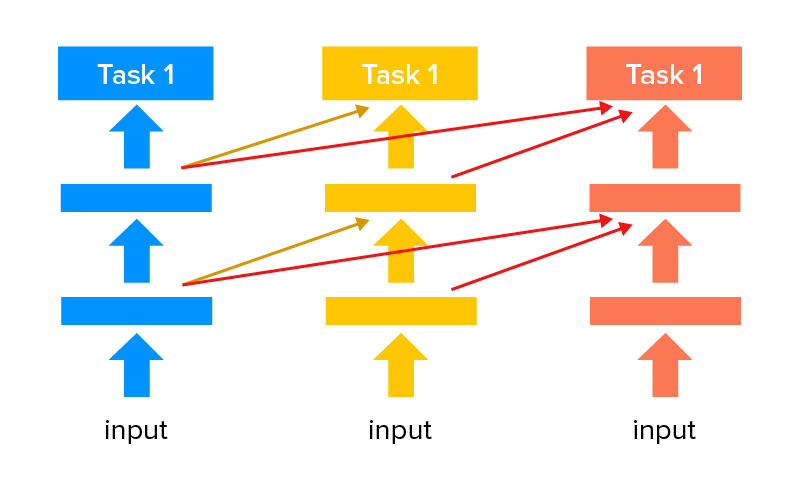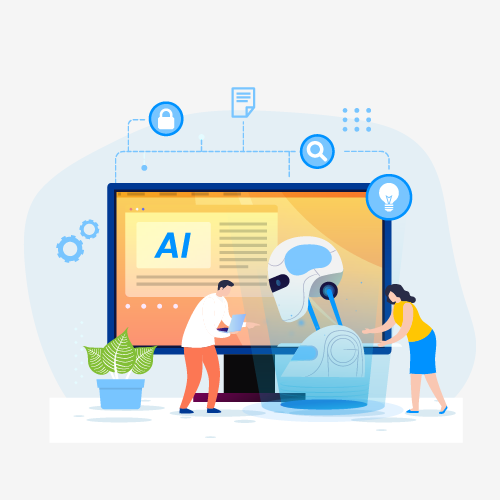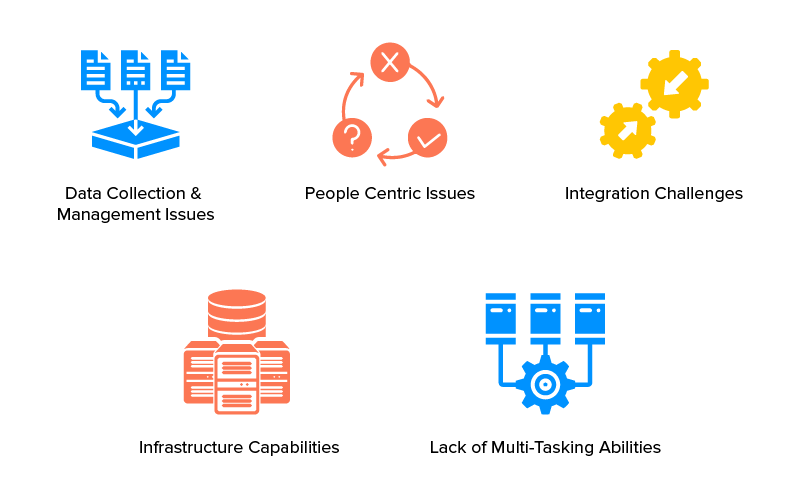How We Solve AI Development Issues You’re Bound to Encounter
Majority of the traditional, conventional software development environment follows the usual phases which include analyze, plan, design, build, quality assurance, and deployment.
The environment of development of artificial intelligence, however, works differently. In the case of AI projects, development is centred around identifying the data source and collecting data, cleansing it, and turning them into insights. Such an approach calls for a different mindset and skill sets.
This unconventionalism that is networked into Artificial Intelligence projects comes with a whole new set of issues and answers for how to solve AI development challenges.
Our team of artificial intelligence development specialists have worked on around 7 full-fledged solutions and 17+ POCs, with no two belonging to the same industry. The work exposure has made a few things very clear to us –
- You cannot expect your AI software development project outcome to be the same as a conventional product’s, for with AI, the game is more around hit and trials.
- You will be able to best implement AI strategies and programs in your business when the entire team is on board, and not just the techies.
- Like in the case of non-AI app projects, the limitations in case of AI projects too vary from one idea to another. But there are some AI developmental challenges and solutions that are similar across products.
Digging at the third learning, there are issues which are similar across products, no matter which idea backs them. No matter which application we were developing, we encountered these issues, making it safe to assume that these are recurrent.
In order to imbibe in entrepreneurs a proactive approach, or data engineers have listed down the commonly occurring issues to adopting AI development services along with their insight against every individual artificial intelligence difficulties and opportunities.
AI Developmental Challenges and Solutions
1. Data collection & management issues
The statement that the AI system is only as good as the data it is based on, while common, comes with several inherent issues. The issues that come on this front are mainly in terms of data gathering and its refinement. But there are other challenges as well, like –
A. Data quality and quantity
As mentioned above, the quality of the AI system depends heavily on the quantity and quality of data that is fed into the system. In order to identify patterns and behave like what is expected of it, AI needs a lot of quality data.
At Appinventiv, we start the process to implement AI strategies and programs by listing down the data that we have and the data which the model needs to operate. To do that, we use both open data and Google’s dataset search for getting access to the data that helps train the model.
-
Labeling of data
Till a few years back, the majority of the data was textual and structured. But with the inception of omni-channel customer experience and Internet of Things, the data type that is being feeded in the business system is majorly unstructured. The problem is that the majority of the AI systems are trained to work around supervised datasets.
At Appinventiv, we use multiple approaches to handle data labeling, revolving majorly around data programming and synthetic labeling, feedback loop system, etc. when answering how to solve AI development challenges.
-
Data biasness
The stories around AI being biased are widespread. Question is how does that happen, especially since the technology is not conscious and thus cannot have bad intentions, right?
Biasness fosters from wrongly collected data. This is the bottomline. When the source of the data is biased, the system becomes discriminatory.
We look at all the data, ensuring they are unbiased from the very beginning. This way, when they enter the AI system, there is no scope of biases in the picture.
-
Case-focused learning
Human intelligence allows us to apply experience from one field to another. It is not something that AI can handle with ease.
AI-powered tools for business are specialized. It is supposed to carry out a single-handed task. Going by its core complexity, it can be very difficult for AI to use the experience that it derived from one project to use it in another.
We use a Transfer Learning approach where we train the AI model to carry out a task and then apply the learning to a similar activity. It means that the model devised for task A can later be used as the starting point for task B model.
2. People centric issues
Even amidst widespread AI adoption, the human resources who are comfortable with working around the technology are counted. This, in turn, causes a number of persistent challenges for businesses both in the short and long term when they create AI-based applications.
-
Absence of understanding among non-technical employees
AI implementation calls for the management to understand AI technologies, their opportunities and limitations, etc. the absence of know-how hinders the right adoption of AI in business, in places where it can, in actuality, have an impact.
-
Rarity of field specialists
What the AI industry needs is experts who have the blend of technical understanding and market know-how for AI problems and techniques. The problem is that finding full-time in-house resources who have the blend of both is really difficult, especially with FAMGA group hiring talent having the core skills needed for AI software development.
This is the number one reason why businesses often outsource their AI solution development to AI app development company like ours which are made of a team of experts who also have an in-depth knowledge of industries.
3. Integration challenges
Adding or integrating Artificial Intelligence in your current system is a lot more complicated a process than adding a plugin in your browser. There are multiple elements and interfaces which are to be set up to address your business needs.
Our team of data scientists consider your individual data infrastructure needs, data labeling, storage, and the process of feeding data in the system, so that you don’t have to face any startup AI app implementation challenges. We also work on training the model and testing effectiveness of the AI, thus developing a feedback loop for improving the models on the basis of people’s actions.
4. Infrastructure capabilities
Handling data and its computation, storage, scaling, security, extensibility etc are all necessary for businesses to deploy AI solutions. The success of a business when they deploy an AI solution begins with answering how suitable their infrastructure environment is and how well does it support the workloads and AI applications. The answer, sadly, is also one of the biggest enterprise AI challenges.
There are a few things that our business analysts take note of at the very early stages:
- The right blend of high speed storage and processing capabilities for supporting deep learning and machine learning models.
- The best software which can be optimized and tuned for fitting the underlying hardware.
- An interface which manages most of the moving components and parts.
- An infrastructure that can be deployed in the cloud or on premise data centre for optimized performance.
5. Lack of multi-tasking abilities
Deep Learning models are extremely trainable. Once the training ends, you can be sure that the solution will do its irrespective task best, whether it is identifying objects or recommending products on the basis of your customers’ search history.
This is one of the biggest problems in AI when you want the system to multi-task. For example, when you want the AI to identify the person in a video and track the origins of the song that is playing in the background, the efficiency will be lost.
A solution to this problem, that our data engineers have identified, is the use of progressive neural networks. It means, connection of separate deep learning models in a way that the bits of information can easily pass. Although we are yet to apply the model in practice, the method is proven to be extremely useful in robotic arms development – speeding their learning from weeks to only one day.

This was our take on the AI developmental challenges and solutions. But the tips to overcome AI development difficulties doesn’t just end with these. As you deep dive into the AI project devise and deployment world, you will find that the implementation of AI problems to solve and provide answers to business ultimately comes down to the skillset and technical + business understanding that your partnered Artificial Intelligence development company has.
6. Human-level interaction
This is possibly the main challenge in AI, one that has saved researchers on edge for AI services in organizations and new businesses. These organizations may be boasting above 90% exactness, however people can improve in all these situations. For instance, let our model predict whether the picture is of a dog or a cat. The human can foresee the right output everytime without fail, wiping up a staggering accuracy of above 99%.
For a profound learning model to play out a similar performance would require remarkable finetuning, hyperparameter advancement, huge dataset, and a well-defined and accurate algorithm, alongside robust processing power, continuous training on train data and testing on test data. That sounds like a ton of work, and it’s in reality multiple times more troublesome than it appears.
A one way solution you can try not to do all the difficult work is simply by utilizing a specialist organization, for they can prepare explicit deep learning models utilizing pre-trained models. They are trained on a huge number of pictures and are tweaked for greatest precision.
7. Data scarcity
With major companies such as Google, Facebook, and Apple facing charges regarding unethical use of user data generated, various countries such as India are using stringent IT rules to restrict the flow. Thus, these companies now face the problem of using local data for developing applications for the world, and that would result in bias.
With big organizations, like Google, Facebook, and Apple dealing with indictments in regards to unethical utilization of user data generated, different nations, like India are using severe IT rules to limit the data flow. Hence, these organizations presently deal with the issue of using nearby local information for creating applications for the world, and that would bring bias result.
The data is a vital aspect of AI, and the labeled information is utilized to train machines to learn and make predictions. A few organizations are trying to invent new strategies and are centered around developing AI models that can give precise outcomes regardless of the scarcity of data. With one-sided data or biased information, the whole system could get defective.
Concluding Thoughts
With an ever growing demand for adaptable, secure, and unique applications, there is tremendous tension in the development community. In such cases, adopting AI technology will give basic solutions and a favorable place to breed innovation. Artificial intelligence and machine Learning are without a doubt the future of programming and software development, and embracing them is the best choice for the organizations to make.
The App development process comprises a number of activities and an expert to perform it. The development significantly contributes to the different factors of AI development based on the location, such as the pricing factor, development, tools, etc. depend from place to place from AI development services in USA to services in other parts of the globe.
FAQs About AI Developmental Challenges and Solutions
Q. What challenges do companies face when implementing AI?
There are a number of issues that companies face when they implement AI in their business. Here are a few of them –
- Data collection and refinement
- Lack of skill set
- Integration challenges
- Infrastructure capabilities
Q. How to resolve AI development challenges?
The solutions to AI developmental issues ultimately come down to the partnership with a team of skilled AI experts and understanding of the users and the market the solution will be focusing on.
Q. What are major ethical concerns about the use of AI?
These are some of the most prominent ethical concerns surrounding artificial intelligence – loss of jobs, biasness, the scope of AI making grave mass-scaled mistakes, the probability of people tampering with the datasets to meet their ulterior motives.

strategies your digital product..





